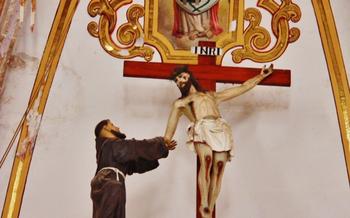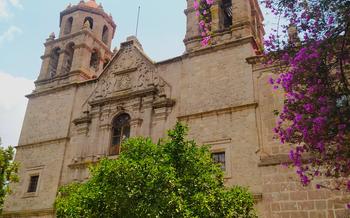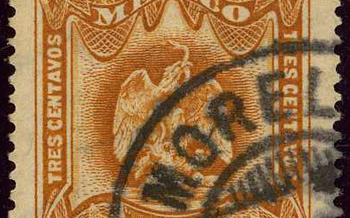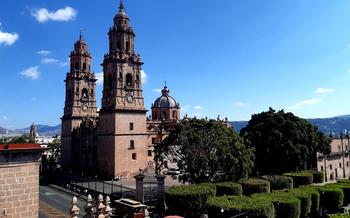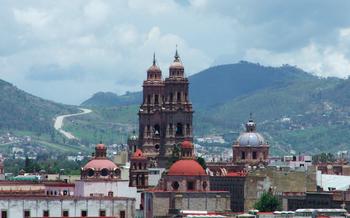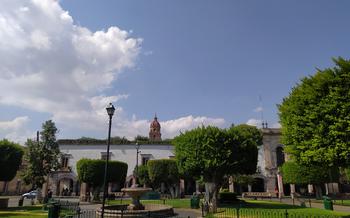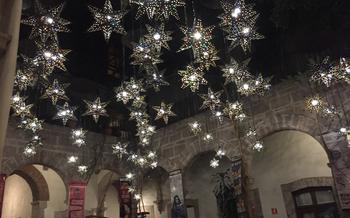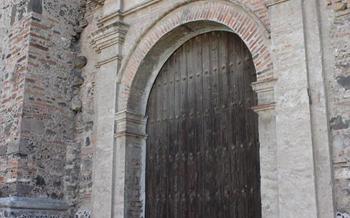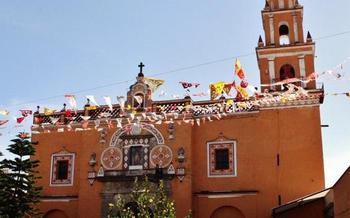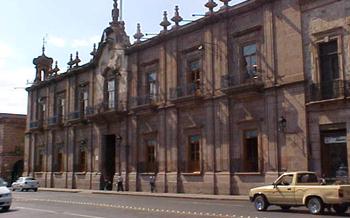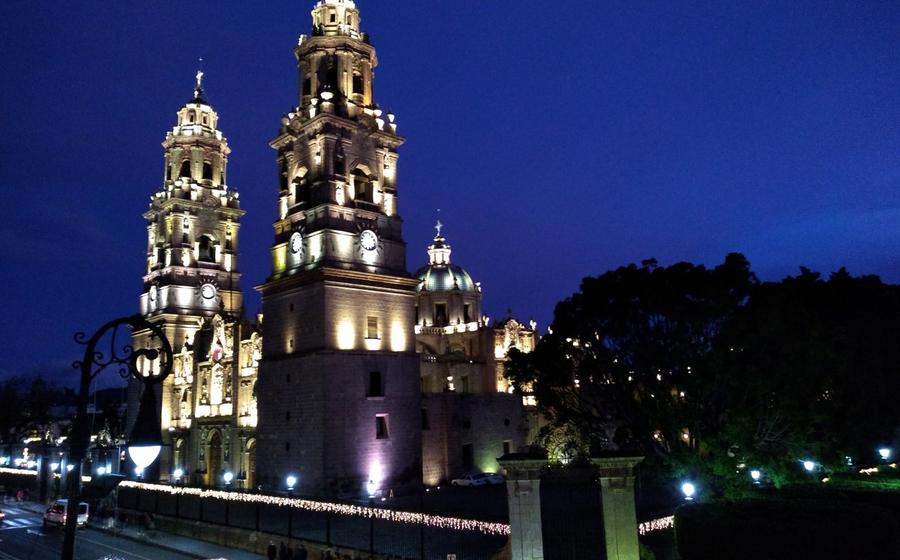
Catedral de Morelia
- Historical Significance
- Architectural Marvel
- Interior Grandeur
- Rooftop Views: A Panoramic Perspective of Morelia's Colonial Charm
- Religious Significance
- Cultural Symbol
- Guided Tours
- Photography Opportunities
- Accessibility
- Dress Code: Respecting the Sacred Space
- Souvenirs and Gifts
- Nearby Attractions
- Local Cuisine:
- Safety Tips:
- Insider Tip: The Hidden Chapel
Historical Significance
The Catedral de Morelia stands as a testament to Morelia's rich colonial heritage, its construction spanning the 17th and 18th centuries. Inspired by Spanish Baroque architecture, the cathedral embodies the fusion of European and indigenous influences that shaped Mexico's cultural identity. Its designation as a UNESCO World Heritage Site underscores its exceptional universal value, while its association with prominent historical figures, such as Bishop Vasco de Quiroga, adds to its historical significance. As a symbol of Morelia's enduring legacy, the cathedral invites visitors to delve into the city's captivating past.
Architectural Marvel
The Catedral de Morelia stands as a testament to the grandeur of Baroque architecture, captivating visitors with its intricate facade and harmonious fusion of Gothic and Renaissance elements. The striking pink tezontle stone, quarried from nearby hills, lends the cathedral a unique reddish hue that sets it apart from other colonial buildings in Mexico. Its imposing facade boasts intricate carvings and sculptures that narrate biblical stories and depict saints and angels. The fusion of Gothic pointed arches and Renaissance classical columns creates a dynamic interplay of architectural styles, showcasing the skill and artistry of the cathedral's builders.
The massive dome, one of the largest in Mexico, dominates the skyline and is visible from various points throughout the city. Its graceful curves and intricate tilework reflect the influence of the Spanish Renaissance and add a touch of elegance to the cathedral's overall design. The harmonious blend of architectural elements creates a visually stunning masterpiece that leaves visitors in awe and admiration.
Interior Grandeur
The interior of the Catedral de Morelia is a testament to the grandeur and opulence of Baroque architecture. Its vast expanse is adorned with elaborate altars, paintings, and sculptures, each a masterpiece in its own right. The 18th-century altarpiece is a particularly notable work of art, considered a masterpiece of Mexican Baroque. Its intricate carvings and gilded details depict scenes from the life of Christ and the Virgin Mary, creating a sense of awe and wonder. The stained glass windows, depicting biblical scenes, bathe the interior in a soft and colorful light, adding to the cathedral's ethereal atmosphere. The impressive pipe organ, one of the largest in Latin America, is a testament to the cathedral's musical heritage. Its majestic sounds reverberate through the vast space, creating a truly immersive and unforgettable experience.
Rooftop Views: A Panoramic Perspective of Morelia's Colonial Charm
The climb to the Catedral de Morelia's rooftop is a rewarding experience that unveils breathtaking vistas of the city and its surroundings. As you ascend the narrow spiral staircase, anticipation builds with each step. Upon reaching the summit, a panoramic spectacle unfolds before your eyes. The city's colonial architecture, with its pastel-hued facades and terracotta-tiled roofs, forms a picturesque tableau. The surrounding mountains, with their verdant slopes and majestic peaks, create a dramatic backdrop.
The rooftop terrace offers a unique perspective on the cathedral's grand dome, showcasing its intricate details and sheer size. It's a place of contemplation and reflection, where visitors can soak in the beauty of Morelia and appreciate its rich history. The rooftop is open to the public during specific hours, and a modest entrance fee is charged. It's advisable to visit during the golden hours of sunrise or sunset to capture the city bathed in a warm, ethereal glow.
Religious Significance
The Catedral de Morelia holds immense religious significance as the seat of the Roman Catholic Archdiocese of Morelia. It serves as a central place of worship for the local Catholic community, hosting regular masses, prayer services, and other religious ceremonies. The cathedral's grand interior provides a sacred space for the faithful to gather, pray, and connect with their spiritual beliefs.
Throughout the year, the cathedral plays host to significant religious festivals and events that draw pilgrims and visitors from near and far. These celebrations, such as the Feast of the Assumption and the Holy Week processions, showcase the deep devotion of the local people and provide a glimpse into the rich spiritual heritage of Morelia.
Beyond its religious functions, the Catedral de Morelia is a symbol of the city's cultural and spiritual identity. Its towering presence and intricate architecture reflect the deep-rooted faith and traditions of the Mexican people. The cathedral serves as a reminder of the enduring power of religion in shaping the cultural landscape of Morelia.
Cultural Symbol
The Catedral de Morelia stands as a proud symbol of Mexican identity and cultural heritage. Its unique blend of indigenous and European influences reflects the rich tapestry of Mexican history and culture. The cathedral represents the fusion of two worlds, embodying the resilience and creativity of the Mexican people. It serves as a reminder of the country's complex past and the harmonious coexistence of different cultures.
For the people of Morelia, the cathedral holds a special place in their hearts. It is a source of pride and a symbol of their city's cultural identity. The cathedral's grandeur and beauty have made it a popular subject in Mexican art, literature, and music. Its iconic silhouette is often depicted in paintings, photographs, and films, showcasing its enduring significance in the Mexican cultural consciousness.
Guided Tours
For a more in-depth understanding of the Catedral de Morelia's history, architecture, and religious significance, guided tours are available in various languages. These tours, led by knowledgeable and experienced guides, provide visitors with insights and anecdotes that bring the cathedral to life.
By joining a guided tour, visitors can learn about the symbolism behind the cathedral's intricate carvings, the stories depicted in the stained-glass windows, and the significance of the impressive pipe organ. Guides can also provide historical context, explaining the role of the cathedral in the city's development and its designation as a UNESCO World Heritage Site.
Tours typically last for around an hour and cover the highlights of the cathedral's interior and exterior. Schedules and rates may vary, so it is advisable to check in advance and book a tour to avoid any disappointment. Specialized tours, such as art history or photography tours, may also be available for those with specific interests.
Photography Opportunities
The Catedral de Morelia is a photographer's paradise, offering endless opportunities for capturing stunning images. With its intricate facade, impressive dome, and elaborate interior, the cathedral presents a feast for the eyes. The best angles for photography are from the front, showcasing the majestic facade, and from the side, highlighting the cathedral's imposing profile against the blue sky. For interior shots, the best lighting conditions are during the morning or late afternoon, when the sun's rays cast a warm glow on the cathedral's interior. Remember to be respectful and avoid using flash photography, as it may disturb other visitors or damage the cathedral's delicate artwork. Please adhere to any photography restrictions or guidelines that may be in place to preserve the sanctity of this sacred space.
Accessibility
The Catedral de Morelia is committed to ensuring that all visitors, regardless of their abilities, can enjoy the cathedral's beauty and grandeur. The cathedral is wheelchair accessible, with ramps and elevators providing access to all levels of the building. Accessible restrooms are also available for the convenience of visitors with disabilities. The cathedral staff is always willing to assist visitors with disabilities, ensuring that they have a comfortable and enjoyable experience. The Catedral de Morelia is a place of worship and a cultural landmark, and it is important that everyone has the opportunity to experience it.
Dress Code: Respecting the Sacred Space
When visiting the Catedral de Morelia, it is essential to dress appropriately, demonstrating respect for its religious significance. For men, this means avoiding shorts, tank tops, and flip-flops. Long pants and a collared shirt are generally considered appropriate attire. Women should also dress modestly, avoiding revealing clothing or short skirts. While the cathedral welcomes visitors from all backgrounds, it is important to remember that it is an active place of worship, and dressing respectfully is a sign of consideration for the local community.
Souvenirs and Gifts
At the Catedral de Morelia, visitors can purchase a variety of souvenirs and religious items to commemorate their visit. These items hold significant meaning for many visitors, serving as tangible reminders of their spiritual journey or admiration for the cathedral's beauty. Within the cathedral premises, there are designated shops or stalls where visitors can find a range of items, including rosaries, crucifixes, statues of saints, and postcards featuring stunning images of the cathedral.
Purchasing souvenirs from the cathedral not only allows visitors to take home a piece of its history and grandeur but also supports the local artisans and craftsmen who create these beautiful items. Visitors can feel good knowing that their purchases contribute to the preservation of traditional Mexican crafts and help sustain the livelihoods of the local community.
Nearby Attractions
The Catedral de Morelia is conveniently located in the heart of the city, surrounded by a wealth of other notable attractions. Within easy walking distance, visitors can explore the Plaza de Armas, the main square of Morelia, which features the Fuente de las Tarascas, a beautiful fountain adorned with bronze sculptures. The Museo del Estado de Michoacán, housed in a former convent, showcases a collection of pre-Hispanic artifacts, colonial art, and contemporary works. For a taste of local history, the Museo Casa Natal de Morelos, the birthplace of Mexican independence hero José María Morelos y Pavón, offers a glimpse into his life and legacy. Art enthusiasts can visit the Museo de Arte Contemporáneo Alfredo Zalce, which exhibits modern and contemporary Mexican art, including works by renowned artist Alfredo Zalce. To experience the city's vibrant culinary scene, the nearby Mercado de San Juan, a traditional market, offers a variety of local delicacies and handicrafts.
Local Cuisine:
Morelia's culinary scene is a vibrant tapestry of flavors, aromas, and textures, offering a feast for the senses. Savor the succulent carnitas, tender pork slow-cooked to perfection and served with fresh tortillas and salsa. Indulge in the delectable enchiladas, corn tortillas stuffed with a variety of fillings, such as cheese, beans, or chicken, and topped with a rich, flavorful sauce. Don't miss the sopa tarasca, a traditional Morelian soup made with fresh vegetables, hominy, and aromatic spices, a hearty and comforting dish that will warm your soul.
For an authentic Morelian dining experience, venture into the city's vibrant markets, where you can sample fresh, local ingredients and interact with friendly vendors. Be sure to try the mouthwatering street food, such as tacos, tamales, and gorditas, prepared with love and expertise by local cooks.
Morelia also hosts several food festivals and culinary events throughout the year, showcasing the region's rich gastronomic heritage. Immerse yourself in the flavors of Morelia and let your taste buds dance with delight.
Safety Tips:
When exploring Morelia, it's essential to prioritize your safety. Familiarize yourself with common tourist scams, such as fake tour guides or overpriced souvenirs. Avoid displaying valuables in public and be cautious of pickpockets in crowded areas. Stay vigilant and aware of your surroundings, especially at night. Respect local customs and traditions to avoid misunderstandings. In an emergency, dial 911 for assistance. By following these safety tips, you can ensure a safe and enjoyable journey in Morelia.
Insider Tip: The Hidden Chapel
For an exclusive glimpse into the cathedral's hidden treasures, venture to the Capilla de las Reliquias (Chapel of the Relics), located behind the main altar. This secret chapel houses a collection of sacred relics, including bone fragments of saints and martyrs. The chapel is usually closed to the public, but special permission can sometimes be granted upon request. Visitors who are fortunate enough to gain access will be rewarded with a rare and intimate experience, immersing themselves in the cathedral's deep spiritual history.
